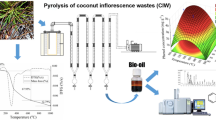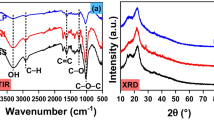Abstract
Hydrothermal liquefaction is a promising anaerobic thermochemical process for the conversion of wet biomass into an energy dense biocrude. In this study, the suitability of orange peel for biocrude production was investigated. The study was carried out at varying temperatures (200 to 300 °C), reaction time (20 to 60 min), and total solids loading (15 to 25%). The optimum operating conditions for recovering maximum biofuel from biomass (28.4 wt%) were found to be 275 °C temperature, 40-min reaction time, and 25% total solids loading. The Box-Behnken design of response surface methodology was used to examine the effect of reaction parameters on biocrude yield and its byproducts and resulted the temperature to be the most effective followed by reaction time and total solids loading. The heating value of biocrude was 32 MJ/kg with flash point of about 93 °C. The obtained biocrude had comparable fuel properties with those of diesel and bio-diesel standards. The GC-MS and FTIR analyses proved biocrude as a complex mixture of alkanes, alkenes, aliphatic and aromatic acids, and alcohols and aqueous phase byproduct as a rich chemical source consisting of esters, alcohols, and ketones which provides a futuristic approach to drop in advanced fuels and chemicals from biocrude.







Similar content being viewed by others
References
MNRE (2020) Bioenergy overview: Ministry of New and Renewable Energy, Government of India. https://mnre.gov.in/bio-energy/current-status. Accessed 21 Nov 2020
Li H, Liu Z, Zhang Y et al (2014) Conversion efficiency and oil quality of low-lipid high-protein and high-lipid low-protein microalgae via hydrothermal liquefaction. Bioresour Technol 154:322–329. https://doi.org/10.1016/j.biortech.2013.12.074
Eboibi BE-O, Lewis DM, Ashman PJ, Chinnasamy S (2014) Hydrothermal liquefaction of microalgae for biocrude production: improving the biocrude properties with vacuum distillation. Bioresour Technol 174:212–221. https://doi.org/10.1016/j.biortech.2014.10.029
Beims RF, Hu Y, Shui H, Xu C (2020) Hydrothermal liquefaction of biomass to fuels and value-added chemicals: products applications and challenges to develop large-scale operations. Biomass Bioenergy 135:105510. https://doi.org/10.1016/j.biombioe.2020.105510
Ruiz HA, Rodríguez-Jasso RM, Fernandes BD, Vicente AA, Teixeira JA (2013) Hydrothermal processing, as an alternative for upgrading agriculture residues and marine biomass according to the biorefinery concept: a review. Renew Sust Energ Rev 21:35–51. https://doi.org/10.1016/j.rser.2012.11.069
Gu X, Martinez-Fernandez JS, Pang N, Fu X, Chen S (2020) Recent development of hydrothermal liquefaction for algal biorefinery. Renew Sust Energ Rev 121:109707. https://doi.org/10.1016/j.rser.2020.109707
Vardon DR, Sharma BK, Scott J et al (2011) Chemical properties of biocrude oil from the hydrothermal liquefaction of Spirulina algae, swine manure, and digested anaerobic sludge. Bioresour Technol 102:8295–8303. https://doi.org/10.1016/j.biortech.2011.06.041
MAFW (2020) Area and production of horticulture crops for 2019-20 (third advance estimates): Ministry of Agriculture & Farmers’ Welfare, Government of India. https://agricoopnicin/statistics/horticulture. Accessed 03 Nov 2020
Teixeira F, Santos BA, Nunes G et al (2020) Addition of orange peel in orange jam: evaluation of sensory, physicochemical, and nutritional characteristics. Molecules 25(7):1670. https://doi.org/10.3390/molecules25071670
Mythili R, Venkatachalam P, Subramanian P, Uma D (2013) Characterization of bioresidues for biooil production through pyrolysis. Bioresour Technol 138:71–78. https://doi.org/10.1016/j.biortech.2013.03.161
Adams P, Bridgwater T, Lea-Langton A, Ross A, Watson I (2018) Biomass conversion technologies. In: Greenhouse Gases Balances of Bioenergy Systems 107–139. https://doi.org/10.1016/b978-0-08-101036-5.00008-2
Gagić T, Perva-Uzunalić A, Knez Ž, Škerget M (2018) Hydrothermal degradation of cellulose at temperature from 200 to 300 °C. Ind Eng Chem Res 57(18):6576–6584. https://doi.org/10.1021/acs.iecr.8b00332
Brindhadevi K, Anto S, Rene ER, Sekar M, Mathimani T, Thuy LCN, Pugazhendhi A (2021) Effect of reaction temperature on the conversion of algal biomass to bio-oil and biochar through pyrolysis and hydrothermal liquefaction. Fuel 285:119106. https://doi.org/10.1016/j.fuel.2020.119106
Theegala CS, Midgett JS (2012) Hydrothermal liquefaction of separated dairy manure for production of bio-oils with simultaneous waste treatment. Bioresour Technol 107:456–463. https://doi.org/10.1016/j.biortech.2011.12.061
Watson J, Lu J, de Souza R, Si B, Zhang Y, Liu Z (2019) Effects of the extraction solvents in hydrothermal liquefaction processes: Biocrude oil quality and energy conversion efficiency. Energy 167:189–197. https://doi.org/10.1016/j.energy.2018.11.003
Mishra S, Mohanty K (2020) Co-HTL of domestic sewage sludge and wastewater treatment derived microalgal biomass – an integrated biorefinery approach for sustainable biocrude production. Energy Convers Manag 204:112–312. https://doi.org/10.1016/j.enconman.2019.112312
ASTM D93-16a (2016) Standard test methods for flash point by Pensky-Martens closed cup tester. ASTM International, West Conshohocken, PA
ASTM D92-16b (2016) Standard test method for flash and fire points by Cleveland open cup tester. ASTM International, West Conshohocken, PA
ASTM D5771-17 (2017) Standard test method for cloud point of petroleum products and liquid fuels (optical detection stepped cooling method). ASTM International, West Conshohocken
ASTM D5853-17 (2017) Standard test method for pour point of crude oils. ASTM International, West Conshohocken
ASTM D5002-16 (2016) Standard test method for density and relative density of crude oils by digital density analyzer. ASTM International, West Conshohocken
ASTM D7042-16e3 (2016) Standard test method for dynamic viscosity and density of liquids by Stabinger viscometer (and the calculation of kinematic viscosity). ASTM International, West Conshohocken
ASTM D4868-17 (2017) Standard Test method for estimation of net and gross heat of combustion of hydrocarbon burner and diesel fuels. ASTM International, West Conshohocken
Jena U, Das KC (2011) Comparative evaluation of thermochemical liquefaction and pyrolysis for bio-oil production from microalgae. Energy Fuel 25:5472–5482. https://doi.org/10.1021/ef201373m
NREL (2016) Biodiesel handling and use guide, 5th edn. National Renewable Energy Laboratory, Golden, CO, USA
Shah AA, Toor SS, Seehar TH et al (2020) Bio-crude production through aqueous phase recycling of hydrothermal liquefaction of sewage sludge. Energies 13(2):493. https://doi.org/10.3390/en13020493
Ghadge SV, Raheman H (2006) Process optimization for biodiesel production from mahua (Madhuca indica) oil using response surface methodology. Bioresour Technol 97:379–384. https://doi.org/10.1016/j.biortech.2005.03.014
Seehar TH, Toor SS, Shah AA, Pedersen TH, Rosendahl LA (2020) Biocrude production from wheat straw at sub and supercritical hydrothermal liquefaction. Energies 13(2):3114. https://doi.org/10.3390/en13123114
Tanushree P, Arindam S, Divya B, Kannan P, Pugazhenthi G, Piet NLL (2020) Bio-oil production from oleaginous microorganisms using hydrothermal liquefaction: a biorefinery approach. Crit Rev Environ Sci Technol. https://doi.org/10.1080/10643389.2020.1820803
Biller P, Ross AB (2011) Potential yields and properties of oil from the hydrothermal liquefaction of microalgae with different biochemical content. Bioresour Technol 102:215–225. https://doi.org/10.1016/j.biortech.2010.06.028
Dandamudi KPR, Muppaneni T, Markovski JS, Lammers P, Deng S (2019) Hydrothermal liquefaction of green microalga Kirchneriella sp. under sub- and super-critical water conditions. Biomass Bioenergy 120:224–228. https://doi.org/10.1016/j.biombioe.2018.11.021
Reddy HK, Muppaneni T, Ponnusamy S et al (2016) Temperature effect on hydrothermal liquefaction of Nannochloropsis gaditana and Chlorella sp. Appl Energy 165:943–951. https://doi.org/10.1016/j.apenergy.2015.11.067
Minowa T, Kondo T, Sudirjo S (1998) Thermochemical liquefaction of Indonesian biomass residues. Biomass Bioenergy 14:517–524. https://doi.org/10.1016/S0961-9534(98)00006-3
Mohan D, Pittman CU, Steele PH (2006) Pyrolysis of wood/biomass for bio-oil: a critical review. Energy Fuel 20(3):848–889. https://doi.org/10.1021/ef0502397
Hossain F, Kosinkova J, Brown R, Ristovski Z, Hankamer B, Stephens E, Rainey T (2017) Experimental investigations of physical and chemical properties for microalgae HTL bio-crude using a large batch reactor. Energies 10(4):467. https://doi.org/10.3390/en10040467
Sharma K, Pedersen TH, Toor SS, Schuurman Y, Rosendahl LA (2020) Detailed investigation of compatibility of hydrothermal liquefaction derived biocrude oil with fossil fuel for corefining to drop-in biofuels through structural and compositional analysis. ACS Sustain Chem Eng 8(22):8111–8123. https://doi.org/10.1021/acssuschemeng.9b06253
Vallinayagam R, Vedharaj S, Naser N, Roberts WL, Dibble RW, Sarathy SM (2017) Terpineol as a novel octane booster for extending the knock limit of gasoline. Fuel 187:9–15. https://doi.org/10.1016/j.fuel.2016.09.034
Palomino A, Godoy-Silva RD, Raikova S, Chuck CJ (2020) The storage stability of biocrude obtained by the hydrothermal liquefaction of microalgae. Renew Energy 145:1720–1729. https://doi.org/10.1016/j.renene.2019.07.084
Liu HM, Li MF, Yang S, Sun RC (2013) Understanding the mechanism of cypress liquefaction in hot-compressed water through characterization of solid residues. Energies 6:1590–1603. https://doi.org/10.3390/en6031590
Chen WT, Zhang Y, Zhang J et al (2014) Hydrothermal liquefaction of mixed-culture algal biomass from wastewater treatment system into bio-crude oil. Bioresour Technol 152:130–139. https://doi.org/10.1016/j.biortech.2013.10.111
Koochaki CB, Khajavi R, Rashidi A, Mansouri N, Yazdanshenas ME (2020) The effect of pre-swelling on the characteristics of obtained activated carbon from cigarette butts fibers. Biomass Conv Bioref 10:227–236. https://doi.org/10.1007/s13399-019-00429-x
Li H, Zhu Z, Lu J et al (2020) Establishment and performance of a plug-flow continuous hydrothermal reactor for biocrude oil production. Fuel 280:118605. https://doi.org/10.1016/j.fuel.2020.118605
Hammerschmidt A, Boukis N, Hauer E et al (2011) Catalytic conversion of waste biomass by hydrothermal treatment. Fuel 90:555–562. https://doi.org/10.1016/j.fuel.2010.10.007
Luo L, Sheehan JD, Dai L, Savage PE (2016) Products and kinetics for isothermal hydrothermal liquefaction of soy protein concentrate. ACS Sustain Chem Eng 4(5):2725–2733. https://doi.org/10.1021/acssuschemeng.6b00226
Okoro OV, Sun Z (2020) The characterisation of biochar and biocrude products of the hydrothermal liquefaction of raw digestate biomass. Biomass Conv Bioref. https://doi.org/10.1007/s13399-020-00672-7
Funding
The authors gratefully acknowledge the Indian Council of Agricultural Research (ICAR), New Delhi, India, and the Department of Bioenergy, Tamil Nadu Agricultural University, Coimbatore, for providing necessary funding and infrastructural facilities to carry out the research.
Author information
Authors and Affiliations
Contributions
R. Divyabharathi: conceptualization, formal analysis, methodology, validation, investigation, writing—original draft, writing—review and editing. P. Subramanian: writing—original draft, supervision.
Corresponding author
Ethics declarations
Conflict of interest
The authors declare no competing interests.
Additional information
Publisher’s note
Springer Nature remains neutral with regard to jurisdictional claims in published maps and institutional affiliations.
Rights and permissions
About this article
Cite this article
Divyabharathi, R., Subramanian, P. Biocrude production from orange (Citrus reticulata) peel by hydrothermal liquefaction and process optimization. Biomass Conv. Bioref. 12, 183–194 (2022). https://doi.org/10.1007/s13399-021-01383-3
Received:
Revised:
Accepted:
Published:
Issue Date:
DOI: https://doi.org/10.1007/s13399-021-01383-3




